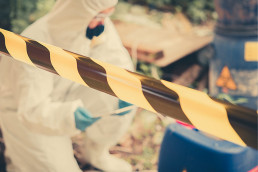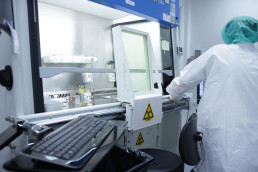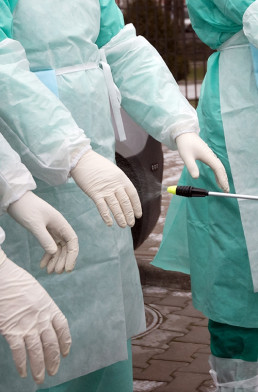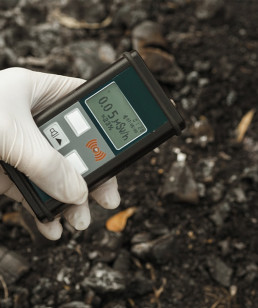Radioactivity has both benefits and drawbacks. It is used in many different areas of everyday life under safe, controlled conditions. In medicine, for example, it provides the basis for x-rays and radiotherapy, a treatment for cancer. Radioactive radiation is also used to produce energy in nuclear power stations. The inherent risk associated with this is reflected in incidents such as the nuclear disaster in Chernobyl in 1986 or that in Fukushima in 2011.
In places where radioactivity is used for the benefit of society, there are therefore strict regulations that are designed to protect workers, the population and the environment against radiation. A key aspect of this is personal protective equipment that is suitable for protecting people against radioactive radiation. So how can we protect ourselves against radioactive radiation? In this blog post, we will give you an overview of the most important means of doing so.
What is radioactivity and which materials provide protection against radioactive radiation?
Most people are aware that radioactivity is dangerous. This fact was discovered by Marie Skłodowska Curie, who carried out extensive research on radiation and coined the term “radioactive”. She died of a blood disorder at the age of 66 as a result of damage to her bone marrow. It is thought that this was caused by Curie’s many years spent handling radioactive materials. But what is radioactive radiation exactly? Radioactive radiation occurs during radioactive decomposition – that is, when the atomic nucleus of certain materials decays. “Radioactive radiation” is actually a pop science term: the technical term is “ionising radiation”. This radiation is subdivided into three types.

Alpha radiation
Alpha radiation consists of helium nuclei – tiny particles that each contain two protons and two neutrons. A sheet of paper or a piece of cardboard provides sufficient protection against this type of radiation. Nonetheless, contact with alpha radiation at close range can cause serious damage to soft tissue. Substances such as uranium, thorium and their decay products radium and radon typically emit alpha radiation.
Beta radiation
Beta rays are made up of electrons, which are negatively charged particles. Aluminium provides protection against this type of radiation, as long as the metal is a few millimetres thick. If people are exposed to beta radiation, it can cause serious harm. Beta radiation is less aggressive than alpha radiation, however. Beta radiation can occur in nuclear incidents, particularly if beta rays are released from iodine-131 or strontium-90.
Gamma radiation
Gamma radiation occurs after the alpha or beta decay of a particle and is made up of short-wave electromagnetic radiation. It is less aggressive than alpha and beta radiation but is very difficult to protect against and can penetrate very deep into the body. Thick layers of lead or concrete are usually required to protect against gamma radiation.
Legal measures for protection against radioactive radiation
Today, the health consequences of exposure to ionising radiation have been extensively researched and are generally well known. As a result, lawmakers have dedicated themselves to protecting individuals who are exposed to radiation. There are now numerous laws and regulations governing the use of radiation. The scientific basis for these regulations is provided by the United Nations Scientific Committee on the Effects of Atomic Radiation (UNSCEAR), a sub-organisation of the UN.
Based on the findings of UNSCEAR, the International Commission on Radiological Protection (ICRP) makes recommendations for the handling of radioactive materials and radioactive radiation. Within the European Union, there are unified regulations governing protection against ionising radiation. These are set out in the EURATOM treaty and must be observed by all member states. Another important law in Germany is the Atomic Energy Act (Atomgesetz/AtG). This includes all the regulations that ensure safe use of atomic energy for peaceful purposes.

Protection against radioactive radiation at work: where are measures required?
Protection is required wherever people are exposed to radiation and wherever sources of hazardous radiation exist. This may include the following sectors:
- Medicine
- Research
- Industry
- Agriculture
- Environmental protection
- Energy production
In Germany, these areas are legally governed by the Radiation Protection Ordinance (Strahlenschutzverordnung/StrlSchV). This lays out measures intended to protect the population against radioactivity as well as the regulations for workplaces in which employees come into contact with ionising radiation. In addition, it specifies threshold values for doses of radiation, which must be checked regularly and not exceeded.
What provides protection against radioactive radiation? The 3 basic rules
To ensure that the threshold values for radiation doses are not exceeded in the workplace, there are three basic rules that form the foundation for protection against radiation.
The basic rules of radiation protection:
- Distance: the distance to the source of radiation must be as great as possible.
- Time: to prevent harmful substances from damaging the body, the time spent near ionising radiation must be as short as possible.
- Shielding: when working with radioactive substances you must shield yourself from the radiation with suitable protective clothing and other safety measures.

Radiation protection with the ALARA principle
There is another basic rule that can be added to these: activity. This refers to how strong the radiation emitted from a substance is. This is where the ALARA principle comes into play.
ALARA stands for “as low as reasonably achievable”. This principle states that the radiation being used – whether in medicine, in research or in energy production at a nuclear power station – should be at a dose high enough to achieve the desired outcome, while also being kept as low as possible in order to prevent harmful effects of the radiation.
This applies during x-rays, for example: the radiation must be strong enough to penetrate the tissues of the body and produce an image of the skeleton. At the same time, however, the radiation must be as low as possible in order to keep the patient and any medical staff attending the procedure safe. Appropriate personal protective equipment is also an important element: patients wear a special x-ray apron which protects them from potentially harmful radiation. Staff in hospitals or doctors’ surgeries who come into contact with x-rays every day also wear specialised protective clothing or leave the room during the x-ray procedure to avoid unnecessary contact with the radiation.

Radiation protection: requirements for equipment
What exactly does protective clothing for ionising radiation look like? And which materials provide protection against radioactive radiation? As already explained, this really depends on the type of radiation. In any case, the most important thing is to follow the three basic rules and the ALARA principle. If direct contact with ionising radiation can’t be avoided, personal protective equipment should include dosimeters, protective suits and respirators.
Dosimeters for measuring the dose of radiation
Dosimeters are used when radioactive radiation is used in a working environment. They are worn on the body and are therefore also called personal dosimeters. The values recorded by the dosimeter are saved and analysed, usually on a monthly basis. There are various types of personal dosimeters which measure radiation in different ways. Examples include film badge dosimeters, thermoluminescent dosimeters and OSL dosimeters.
Protective suits for radioactivity
In addition, special contamination protection suits are offered for protection against radioactivity in the workplace. A distinction is made between protection against radiation, for which there are special heavier garments, and lighter textiles, such as disposable coveralls, which are designed to prevent radioactive particles from settling on people’s clothing or skin or or penetrating the body. These coveralls are certified to DIN EN 1073-2 and provide a barrier against radioactive contamination by solid particles no smaller than 0.6 µm in diameter. This type of protective suit is less about shielding you from radiation, and more about helping you prevent your skin and hair from coming into contact with radioactive materials. After wearing an anti-contamination suit, it should be taken off immediately and disposed of safely so that it does not pose any ongoing risk of contamination.
Masks for radioactive radiation: what type of mask protects against radioactivity?
Another important part of personal protective equipment for working with ionising radiation is respiratory protection against radioactivity, i.e. protective masks. These prevent radioactive particles from entering the body via inhalation or swallowing. But is it possible to protect yourself against radioactive radiation with a respirator? The answer is yes – to a certain degree. Full masks with filter cartridges and single-use particle-filtering FFP3 masks are used for this purpose. These masks not only protect against pathogens such as viruses, bacteria and spores, they also filter out carcinogenic and radioactive substances including nanoparticles. FFP3 masks therefore provide protection against radioactive fallout. This type of mask does not provide general protection against radioactivity, however. For this reason, they are only used if the threshold limit at a workplace exceeds 30 times the sector-specific value at a maximum. Particle-filtering respirators consist of several layers of filtering material such as spunbonded or meltblown fabric. FFP3 masks are usually fitted with an exhalation valve to reduce exhalation resistance and the amount of heat and humidity inside the mask.
Protection against radioactivity with the right equipment
Strict legal measures have been set out by lawmakers to protect people from the risks involved in working with ionising radiation. As a starting point, these include methods such as the basic rules and the ALARA principle which are used to prevent or limit contact with radioactive materials as far as possible. In settings where working with radioactive radiation is part of the daily routine, having the right personal protective equipment is critical. As well as protective suits and dosimeters, certain respirators also help against radioactive radiation – either full masks or FFP3 masks. uvex’s range includes a wide selection of highly effective, comfortable and durable FFP protective masks.